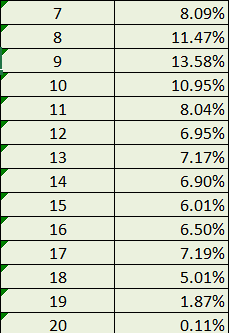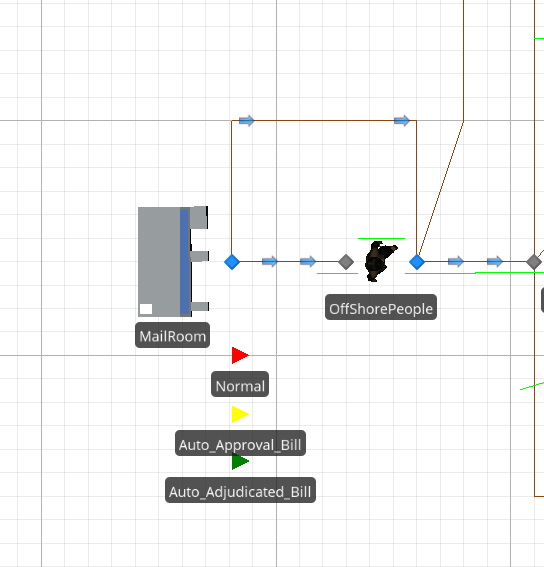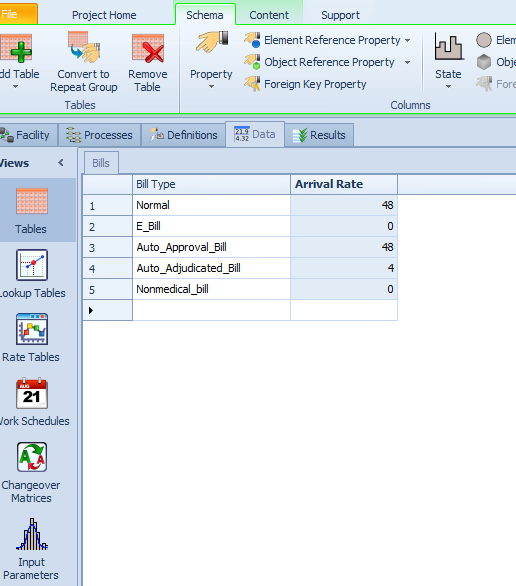Search the Community
Showing results for 'daily arrival'.
-
You want to make the servers have a Capacity Type of Schedule and follow the default Standard Week. If you don't want to give them a lunch break, just change the definition of the Standard Day. Leave the default Off Shift Rule of Suspend Processing. The easiest approach for arrivals is to have a Source with an Interarrival time of 4.33 weeks (or 4 weeks) and an integer random distribution for the Entities Per Arrival. Doing a "first Monday" is possible, but a bit complicated because Simio time does not have the concept of Month because months are of varying size. You could probably specify the initial Time Offset to be early in a month, then maybe make the interarrival time be something like DateTime.DaysInMonth(DateTime.Month(Timenow),DateTime.Year(TimeNow)) which would make the next arrival be exactly one month later (same day of the month). When you say you have no buffers, what do you mean? If an entity arrives when all servers are busy, should it be balked (possibly disposed) or should it wait somewhere like on the server input node, on a path or in the Source output node? If the above arrival approach isn't exact enough, you can put exact arrivals in a data table. The arrival time could be specified at any exact datetime you desire and still have the Entities Per Arrival be a distribution.
- 2 replies
-
- server
- work schedules
-
(and 2 more)
Tagged with:
-
First of all, Thank you so much for the answer in advance, but could I bother anyone who answers with some example model or picture of the method I am still new to SIMIO, so I am concerned about following the advice correctly. 1) Let's say every day I have X number of people arriving( using distribution to generate numbers outside SIMIO randomly). This is the shop where people visit from 8.00 to 20.00 every day with different visit rates per hour (example as below), and I use X to time to this percentage so I can get the exact number of visits per hour. The problem is I want to make an arrival interval random with some sort of function/distribution or table(excel calculation), not a stable arrival rate. My idea is random from 0 to 1 and gives the random number (Y) to match with X outside SIMIO and put the whole table in, but I wonder, is there any better method than this? 2) The second question is about two entities from different sources, A and B. A and B will go through the same server for three servers, but after server 3, one will go to 4, and one will go to 5. Can you give me any advice on how to do that
-
hello :), I'm trying to make a model with three servers. Everyone uses different Workers type and have different operation time per entity (no problem in these points). The difficult part is the next, every work center (server) has a different setup and changeover, and both happens without the presence of the entity. I mean the setup of some servers starts when the entity is created, (before the arrival to that server), and after the operation the changeover has to be done, in both cases we need to use or assing a worker. How can I do that?
-
Well, there are two problems in your model: First, there are many gates that are not following the data table. Second: every gate should be on the Gate table, regardless if they will have flights or not. If not, they will create entities on every single arrival of the departure table. You have many gates that are not included on Gate table.
-
It sounds like you are already set up to use a Source with Arrival Mode of Arrival Time and the Arrival Time Property of MyTable.TimeOffset (assuming that your table above is named MyTable). If the column named Object in your table above is the entity type you want to create, then specify the EntityType in the source to MyTable.Object. If the entity you want to create is something different, then add that new column to your table (say PassengerType) and specify EntityType as MyTable.PassengerType.
-
How to increase the distence between entity to entity ?
jzhou replied to River's topic in SI General Discussions
@River Maybe you can use a Timer element and set its Interval type to Arrival Table and use Timer's event to trigger a Process, within this process, you can do anything you want use process steps. -
How to increase the distence between entity to entity ?
ViniciusF replied to River's topic in SI General Discussions
What you can do is set up a table with a column of DateTime Property for the arrivals and change the Source Arrival Mode accordingly. I strongly recommend you guys to take a look on the Simbits available, they are a really good tool to guide you through your first steps into Simio. For instance, you can find the solution for your problem on a Simbit called AppointmentArrivals. -
I'm still experiencing the same problem and haven't been able to fix it. I could use a regular arrival table, but then my pattern would not be a non-stationairy poisson process. So I think that I really need to use these rate tables, but somehow the inputs of the rate table don't reflect the outputs.
-
Hello Gosia, I recommend using two State Variables to record the start and end times using the function TimeNow upon the Vehicle’s arrival to a Node. A Decide step is needed to check if the Current Node is different from the Destination Node and that is when values of the State Variables are assigned using the Assign step. The Processes will be set at the Vehicle’s Add-On Process Triggers On Entered Node and On Exiting Node. You can visit the SimBit section under the Support ribbon and check the SimBit titled “Record Distance Traveled” to see a similar example. Another approach is to create a custom Vehicle Class and use a Level State Variable instead of the two Real State Variables to collect information of the travel time. I suggest exploring the Level State Variable in the Help pages under the chapter titled “States”. I recommend checking the SimBit titled “Using Level States (from project Infection Propagation Using Continuous And Flow)” as well. Best Regards, Khaled
-
Let's say I want exactly 100 entities arrive where the arrival of each one follows a normal distribution with mean 1 hour and standard deviation of 5 minutes from the start of the simulation. How can I model that within SIMIO? The interarrival time doesn't make sense because I don't know / care what the interrarrival time between each entity is. I realize that I could randomly generate 100 normal random variables outside of SIMIO and input them all as an appointment, but I am wondering if there is a better way especially if I want to do many replications with a different set of 100 random variables each time.
-
Hello, everyone! is it possible to use a Look Up Table and Rate Table to the same time in the source in SIMIO? Let me know if you know a way to do that, please. Thanks for your help!
-
Hi, I want to have a source that creates entities according to a date. But also, I want each entity to carry some information like Code, Processing Time and Type. It is possible to do that? And After, how I can use the information that each entity carry? For example, Each entity has their own processing time (according to the table), how I can use that procesing time in a server? Thanks for your help!!!
-
I have several different types of entities. And I want to see the result if I change the distribution of entity types. EG: senario1: A:10, B:20, C:70 senario2: A:20, B:20, C:60 senario3: A:40, B:20, C:40 I want to run experiments for these 3(Actually I plan to run more and more) different experiments and check the results. I don't know How to do these experiments. Anyone has an idea? Thank you!
-
In the book by SMITH/STURROCK/KELTON, in Section 7-3, the authors warn against manually changing the arrival rate from one period to the other. They state that it will give wrong results at the transitions. The recommendation is to use Rate Tables. Is my guess correct ? Say we have 2 periods of 1 hour each, one with mean = 100 and one with mean = 200. If we use Rate Tables, Simio will use the rate 100 in the first hour BUT will only generate arrivals during the first hour. If we use a manually set rate and change it to 200 after 1 hour, it is possible that in the last few minutes of the first hour, entities might be generated that arrive in the second hour. If not correct, what is the real reason for the author's warning? Thank you
-
In the source of my model, I would like to generate arrival events by looking through row by row of a given table. However, I only want to create the 2nd arrival event when all the entities of the created by the first arrival event has moved beyond a certain point, where Globalstatevalue = 0. So in my process flow, I did something like this:When the globalstatevalue = 0, I want to go to the next row of my table and generate the 2nd arrival. I did this my fire an event The setting at my source: Arrival Mode: On event Triggering Event Name: name of event that I fired in the process flow. I managed to get the initial arrival to make sure that the Globalstatevalue = 0. condition is reached. However, the 2nd event is not triggerd at all and the CurrentRowNumber is not incremented as well. May I have some advice please? Thank you
-
Hello, I have a data table with 900 total entities, comprised of 10 different types of entities. I am trying to randomize which entities go through the model, but I need all 900 to go through. I've tried the "entity mix" technique, but it always overloads my model with too many entities. Does anyone have an idea of how to go about this? I want to run a series of experiments with a random selection of entities for each replication. I hope this makes sense. Thanks in advance! -Mario
-
Hello, I'm very new to SIMIO and apologize if this question is too elementary. I've been trying to figure out how to run the simulation from a defined list of entities. Most of the SIMBITS and examples I have seen use a random "product mix" or other means to produce entities. Is there a way to simply run say, 40 defined mixed entities from the data table. I'd like to run several different entities from the data table, all with different sequences and processing times. Similar to the SIMBIT EntityFollowsSequenceWithTable but with a defined amount of PartA,PartB,and PartC entities. Thank you for the help!
-
Hi, I have a production line with 2 sources. The arrival of entity A in source 1 triggers an arrival of entity B in source 2. Entity A and entity B then enter their respective servers for a processing time. Entity A is processed at table_openings between 10 and 15 minutes with probabilities whereas Entity B is processed at table_MF for 10 minutes. The process type is task sequence. Both Entity join at a combiner. Entity A is the parent and Entity B is the member. Afterwards, the combined entity continue along the production line. I have expected processing times for each task at each server. Before starting a task, a process starts where a state statistic registers the state processing time of the entity. I also put list state to verify the schedule utilization. I have verified visually and the state value for processing time is correct for every station while the simulation is running. What I have observed is that the state statistic average processing time for the servers before the combiner is the expected value, however, all the other stations are 10 minutes off. The simio output has the right processing times for all the stations after the combiner but not for the two stations before the combiner. Moreover, the list state average time busy value are ok for all the stations after the combiner but again the station before the combiner, it gives the total number of minutes it was busy. Also, if i do the average of the state log observation for each station in excel afterwards, I get all the correct processing times. I am guessing it has something to do with the combiner, but I am lost. How can the processing time for table_MF be 10,48 when the processing time is a fixed 10 minutes in the facility window? Why is the list State MF and OP different from all the other list states? Thank you for your help!
-
Hello Simio-Community, I want to simulate a vegetable garden with a source, with a maximum number of vegetables (maximum arrivals in Simio). People can take as much vegetables as they want in the garden until it is empty. Once one vegetable has been gathered it takes a few weeks to grow again. Do you have an idea of how I can handle this ? I'm quite new in Simio. Thank you in advance,
-
I am using arrival table to create my entities inside my simulation. So I am importing a column indicating the arrival time of all my entities; inside my data I also have property associated with each entity (exam type in an ultrasound clinic). I want to use that column as well and attache the associated property to each entity created. I am not sure how to do that. Also I want to use that property in another table and assign processing time distributions for each property (maybe defining the column as a key might help but I am not sure ). I appreciate any help.
-
Hello, I have a model that uses an arrival table to define the sequence to create my entities. In the same table I have the processing times for my servers . I don't know why but seems that my model is simply ignoring my table, entities creation sequence and processing times are not using data from the table. I have tried a lot of things but could not find what is wrong. I hope someone here can help me. Attached is my model. Thanks for the support. Model_2_heads.spfx
-
Dear all, I have a question about modelling arrivals. Entities have to arrive in groups of 5. These 5 entities can be of different entity types. Now in my model, each time an entity "group" of 5 entities arrives, they are all from the same entity type. This is probably because first is decided which type the group will be, and then the 5 entities are created. Each time these 5 entities arrive, there is a Table Reference Assignment referring to the "productmix", from where is decided which entity types will be created. All the entities in the arrival have to be as the percentage in the producttable. So more types per arrival group can arrive. Does somebody know how to model this? Thanks. My model is included as an attachment. Entity_Arrival_Problem.spfx
-
Hello Everyone, I would like to use patient daily arrivals to the ED. I have daily totals, but I want them to follow a pattern (eg. at midnight the arrival is much less than during noon). I am trying to include future forecasts (my forecasts are daily forecasts and not hourly) and this is why I need to somehow input daily numbers into rate table but also make it follow the pattern. Would really appreciate help with this! Thank You! Best regards, Sumanth
-
Hi, I'd like to build a model with arrival and processing times in data tables. I figured out how to create arrivals based on a table - setting arrival mode on a source object into Arrival Table and linking the table column to Arrival Time Property. A real problem is about how to link processing times in a data table to a server object. I set Processing Time of a server object as the table column, but it doesn't work. I know this is a row reference related error, but I don't want to have the RandomRow option, since the processing time should be selected for each entity in the order of processing times in the table. To make a long story short, I have two tables, each of which is for arrival and processing times. Arrival table.Arrival = 0.1, 0.2, 0.3, 0.4, 0.5 Processing table.Proc = 0.05, 0.06, 0.07, 0.08, 0.09 The 1st entity should be created at 0.1, and its processing time should be 0.05. The 2nd entity should be created at 0.2, and its processing time should be 0.06. The 3rd entity should be created at 0.3, and its processing time should be 0.07. The 4th entity should be created at 0.4, and its processing time should be 0.08. The 5th entity should be created at 0.5, and its processing time should be 0.09. For your information, the file has been attached to this post. Anybody can help me with this? Thanks a lot in advance!! Test_Model.spfx









